Introduction to Croatian Landscape issues
Stamps depicting various Croatian towns and scenery, were the first definitive issues in Independent State of Croatia. The stamps were designed by Oto Antonini and Hinko Baranek, their initials can be seen on some values.
The stamps were printed in photogravure by Tipografija d.d. and Hrvatska državna tiskara using many different plates and printing runs from September 1st 1941 to April 7th 1943. The exact dynamic of releases is impossible to determine. As a result, these stamps are classified as one set.
Characteristics
Press sheet
A press sheet consisted of 4 panes, each having 100 stamps in (10 x 10) layout. For most of the values a press element consisted of 2 panes which were imprinted twice on the same press sheet to produce 4 impressions. For some values the press element consisted of 4 panes and in this case all 400 stamps were printed at once. Panes on a press sheet were marked with Roman numerals.
Paper
Stamps were printed on four main types of paper:
- intaglio,
- porous,
- thin and
- offset.
There are also differences within types of papers especially in thickness, smoothness, transparency, structure and color.
According to Novak (cited in Ercegović, 1995: 206) the first runs were printed on intaglio paper, second runs on porous and thin papers and the third runs on offset paper.
Colors
As the stamps were printed in larger time intervals, two printing houses and on different papers, many nuances of colors exist and also minor color spills, mainly around areas with higher concentration of color.
Gum
In first runs printed in Tipografija d.d. on intaglio paper, the gum was applied after the stamps were printed. Two different UV reflections of the gum were observed. Stamps with shiny and half-shiny gum are also known.
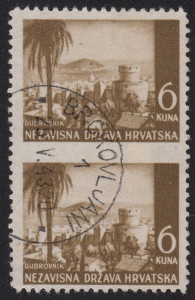 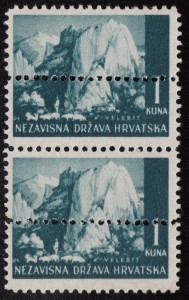 |
Stamps printed on porous paper were also gummed after the printing. Gums in grayish and yellowish color are known, the latter in two color tones.
In case of issues printed on thin paper white and yellowish gum exist. The paper was gummed before printing.
Issues printed on offset and intaglio paper exhibit differences in thickness of coating, especially in case of the latter also partially gummed examples were recorded.
Perforation
It is generally assumed that the stamps were perforated using 6 different blades which resulted in 6 different perforations, ranging from 10 ¾ to 11 ½ (Ercegović, 1995: 215-216). Imperforate stamps were not in circulation.
Coincidental varieties
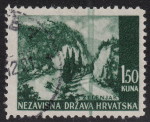 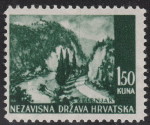 |
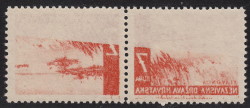 |
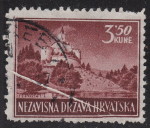 |
Thick and thin lines
On most of the values a (presumed) coincidental variety occurs in form of thin or thick vertical lines, running over the whole of the design. As this occurrence is not discussed in available literature, the reliable judgment can’t be given at this point. The author of this text noted that thin lines are most probably coincidental in nature as on the same position in a pane (printed on the same paper) don’t appear regularly, also a position of a line might differ. Thin and thick lines were noted on most issues.
Other coincidental varieties
The following varieties were noted on all values and all papers:
- offsets
- paper folds and creases (especially on those which were printed on thin paper)
- partially imperforate on 1, 2 or 3 sides
- double perforated
- shifted perforations
Imperforate stamps originate from printer’s waste. Imperforate stamps were never used in postal traffic.
Printer’s waste
Printing of value papers (stamps included) is under strict control. Unsuccessful copies are documented and destroyed and a documentation on the whole process exists. In case of all editions of Independent State of Croatia there was insufficient control over destruction of printer’s waste. As a consequence, large quantities of such materials exist on the market. It is well known that shortly after the stamps were issued, hundreds of items from printer’s waste leaked from the press houses and were sold to collectors and dealers. For some stamps it is impossible to determine whether they derive from printer’s waste or not.
Common types
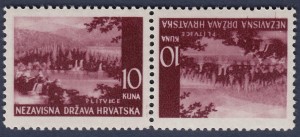 |
Many varieties in this issues are deliberately created. Not only deliberately inserted marks (such as letter U on 3 kuna stamp or letter H on 100 kuna stamp) but also other varieties. As it is impossible to determine which were deliberately produced all the types are described in tables together with constant varieties.
The following values were printed in head-to-tail layout: 0.25 kn, 0.25 kn on 2 kn (provisional issue), 0.50 kn, 1 kn, 1.50 kn, 2 kn, 4 kn, 5 kn (black), 6 kn, 7 kn, 8 kn, 10 kn, 20 kn, 30 kn and 50 kn.
Constant varieties and types
In these issues there’s an abundance of constant varieties, many of them were not recorded in philatelic literature. The exact position of a variety in a pane is indicated in tables, classified according to paper types and plate numbers.
Please select the type below to display constant varieties:
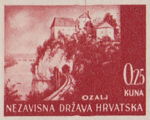 |
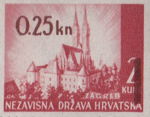 |
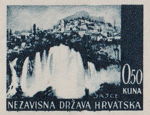 |
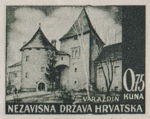 |
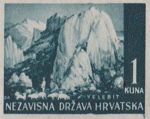 |
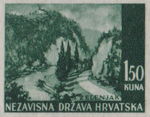 |
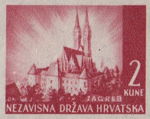 |
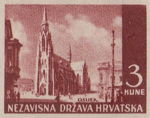 |
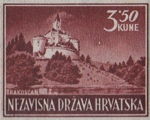 |
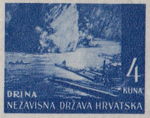 |
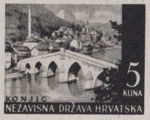 |
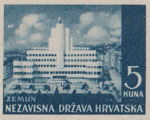 |
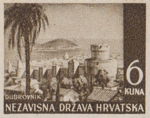 |
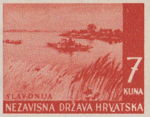 |
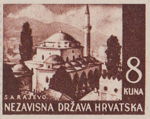 |
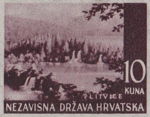 |
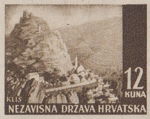 |
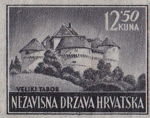 |
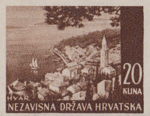 |
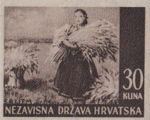 |
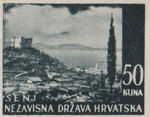 |
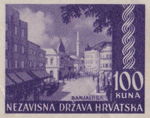 |
Panes
Please note the files are large and they will take time to load.
| Intaglio paper | Porous paper | Thin paper | Offset paper | |||||||||||||
|---|---|---|---|---|---|---|---|---|---|---|---|---|---|---|---|---|
| I | II | III | IV | I | II | III | IV | I | II | III | IV | I | II | III | IV | |
| 0.25 kuna, brick-red | Link | left, right | – | – | Link | Link | – | – | – | – | – | – | Link | Link | – | – |
| 0.25 kuna on 2 kuna, carmine | Missing | Missing | Missing | Missing | – | – | – | – | – | – | – | – | – | – | – | – |
| 0.50 kuna, slate blue | Missing | Missing | Missing | Missing | Missing | Missing | Missing | Missing | Link | Missing | Missing | Missing | Link | Missing | Missing | Missing |
| 0.75 kuna, olive green | Link | Link | – | – | Missing | Link | – | – | – | – | – | – | Missing | Missing | – | – |
| 1 kuna, prussian green | Missing | Link | Missing | Missing | Missing | Missing | Missing | Link | – | – | – | – | Missing | Missing | Link T1 Link T2 |
Missing |
| 1.50 kuna, deep green | Missing | Missing | Missing | Link | Missing | Missing | Link | Link | – | – | – | – | – | – | – | – |
| 2 kuna, carmine | Missing | Missing | Missing | Missing | – | – | – | – | Link | Link | Link | Missing | left, right | Missing | Missing | Link |
| 3 kune, brown red | Link | Missing | – | – | Link | Link | – | – | – | – | – | – | left, right | Missing | – | – |
| 3.50 kuna, brown carmine | – | – | – | – | – | – | – | – | Link | Missing | Missing | Link | Missing | Link | Missing | Missing |
| 4 kuna, ultramarine | Missing | Link | – | – | – | – | – | – | – | – | – | – | Missing | Link | – | – |
| 5 kuna, black | Missing | Missing | – | – | – | – | – | – | – | – | – | – | – | – | – | – |
| 5 kuna, blue | Missing | Missing | – | – | – | – | – | – | – | – | – | – | Missing | left, right | Missing | Link (?) |
| 6 kuna, olive brown | Link (?) | Missing | – | – | – | – | – | – | – | – | – | – | Missing | Missing | – | – |
| 7 kuna, orange red | Missing | left, right | – | – | – | – | – | – | – | – | – | – | Missing | Link | – | – |
| 8 kuna, brown | Missing | Missing | – | – | – | – | – | – | – | – | – | – | Link | Missing | – | – |
| 10 kuna, dark lilac | Missing | Missing | – | – | Link | Missing | – | – | Missing | Link | – | – | – | – | – | – |
| 12 kuna, brownish olive green | Missing | left, right |
– | – | – | – | – | – | – | – | – | – | – | – | – | – |
| 12.50 kuna, violet black | – | – | – | – | – | – | – | – | Link | Missing | Missing | Missing | – | – | – | – |
| 20 kuna, brown | Missing | Missing | – | – | – | – | – | – | – | – | – | – | Link | Link | – | – |
| 30 kuna, black brown | Missing | Missing | – | – | – | – | – | – | – | – | – | – | Missing | Link | – | – |
| 50 kuna, slate green | Missing | Missing | – | – | – | – | – | – | – | – | – | – | left, right | Missing | – | – |
| 100 kuna, lilac | Missing | Missing | – | – | – | – | – | – | – | – | – | – | Link | Link | – | – |
Bibliography
- Ercegović, Velimir (1995): HRVATSKA FILATELIJA – Od predfilatelije do maraka Republike Hrvatske, Agencija za komercijalnu djelatnost, Zagreb ISBN-13: 978-9539641915
- Katalog poštanskih maraka jugoslovenskih zemalja (1991), Jugomarka (Belgrade). YU ISSN 0351-4447

